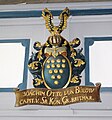Bülow family
This article includes a list of general references, but it lacks sufficient corresponding inline citations. (December 2017) |
| Bülow | |
|---|---|
| Noble family | |
 | |
| Country |
|
| Founded | 13th century |
| Titles | |
| Estate(s) | Several |
The House of Bülow (German pronunciation: [ˈbyːloː]) is the name of an old German and Danish noble family of Mecklenburg origin, members of which have borne the title of Baron (Freiherr), Count (Graf) or Prince (Fürst).[1]
History[edit]
The family traces its main line back to one knight Godofridus de Bulowe, mentioned in a 1229 deed. He was named after the village of Bülow near Königsfeld, then part of the Bishopric of Ratzeburg. The family made great donations to nearby Rehna Abbey.
As Bülow was also a word for oriole in the local dialect based on Wendish roots[citation needed], the bird is depicted as a crest in the family's coat of arms.
In Mecklenburg the family acquired around 110 estates, castles or villages from 1229 onwards, nine of which remained in its possession until the confiscations in communist East Germany in 1945. From 1470 to this day the family holds the manor of Gudow in Saxe-Lauenburg (today part of the former West-German state of Schleswig-Holstein), and in the 19th century it acquired three more estates nearby, also still owned by family members.
In the 14th century, four members officiated as Bishops of Schwerin; one Dietrich von Bülow was Bishop of Lebus from 1490 onwards. Numerous female members joined the convent of Dobbertin Abbey. In 1383 the Mecklenburg knight Heinrich von Bülow burnt down the village and church of Wilsnack; thereafter, the rebuilt Church of the Holy Blood of Wilsnack became a destination of medieval religious pilgrimages.
The most notable family members are Hans von Bülow (1830–1894), pianist, conductor and composer who married Liszt's daughter Cosima, who later left him for Richard Wagner, and Prince Bernhard von Bülow (1849–1929), Chancellor of Germany from 1900 to 1909.
Notable members[edit]
- Andreas von Bülow (born 1937), German politician, former government minister and author of a 9/11 conspiracy book
- Babette von Bülow (1850–1927), German author of short stories, comedies and farces under the male pen name Hans Arnold
- Bernhard Ernst von Bülow (1815–1879), Danish and German statesman, father of the Bernhard von Bülow (below)
- Bernhard von Bülow, Prince (1849–1929), Chancellor of the German Empire from 1900 to 1909
- Bertha von Marenholtz-Bülow (1810–1893), German educator
- Christoph Carl von Bülow (1716–1788), Prussian general under Frederick the Great
- Claus (von Bülow*) (1926–2019), Anglo-Danish lawyer and socialite. (Born Claus Borberg, he adopted his mother's family name.)
- Cosima (von Bülow*) Pavoncelli (born 1967), American socialite and philanthropist, daughter of Claus (von Bülow*) and Sunny (von Bülow*)
- Cosima Wagner daughter of Franz Liszt. Wife of Hans von Bülow, she left von Bülow for composer Richard Wagner.
- Dietrich Heinrich von Bülow (1757–1807), a.k.a. Heinrich Dietrich Bülow, Prussian officer during the Napoleonic Wars, military theorist, and brother of Friedrich Wilhelm von Bülow
- Franz Joseph von Bülow (1861–1915), German writer
- Frederik Rudbek Henrik von Bülow (1791–1858), Danish general leading the defence of Fredericia during the 1849 Battle of Fredericia
- Friedrich Gustav von Bülow (1814–1893), founder of Bothkamp Observatory
- Friedrich Wilhelm Freiherr von Bülow, (1755–1816), Prussian general during the Napoleonic Wars
- Frits Toxwerdt von Bülow, (1872–1955), Danish politician and government minister.
- Hans, Count von Bülow (1774–1825), Westphalian and Prussian statesman and senior president of Silesia
- Hans von Bülow (1830–1894), pianist, conductor and composer who married Liszt's daughter Cosima, who later left him for Richard Wagner
- Hans von Bülow (1816–1897), Prussian general who fought during Austro-Prussian War, and Franco-Prussian War.
- Harry von Bülow-Bothkamp (1897–1976), German fighter ace in two World wars, brother of Walter von Bülow-Bothkamp
- Heinrich von Bülow (1792–1846), Prussian ambassador to England from 1827 to 1840, uncle of Bernhard
- Heinrich von Bülow (Grotekop) (died before 1395/1415?), known as Big Head, who in 1383 destroyed Wilsnack
- Johan Hartvig Victor Carl von Bülow, Rittmester (1754–1823), Norwegian-Swedish vice general during the Swedish-Danish war of Norway
- Johann Albrecht von Bülow (1708–1776), Prussian general under Frederick the Great
- Karl von Bülow (1846–1921), German general during World War I
- Otto von Bülow (1911–2006), German World War II U-boat commander
- Otto von Bülow (diplomat) (1827–1901), Prussian and German diplomat.
- Sunny von Bülow (1932–2008), wife of Claus von Bülow; husband was accused of poisoning her
- Vicco von Bülow a.k.a. Loriot (1923–2011), German humorist, graphic artist
- Walter von Bülow-Bothkamp (1894–1918), German fighter ace, brother of Harry von Bülow-Bothkamp
Heraldry[edit]
The blazon of the family's coat of arms is: Azure, fourteen bezants in pile, displayed four, four, three, two, one. The family's heraldic animal is the oriole, which can be seen in the armorial crest below.
-
Graf Bülow von Dennewitz (1814)
-
Graf von Bülow (1816)
-
Arms of the Bülow family (1858)
-
Epitaph in Friedrichshagen church
-
The oriole as crest, at Doberan Minster
References[edit]
- ^ Gothaisches genealogisches Taschenbuch der gräflichen Häuser (in German). Gotha: Perthes. 1870. p. 193.





